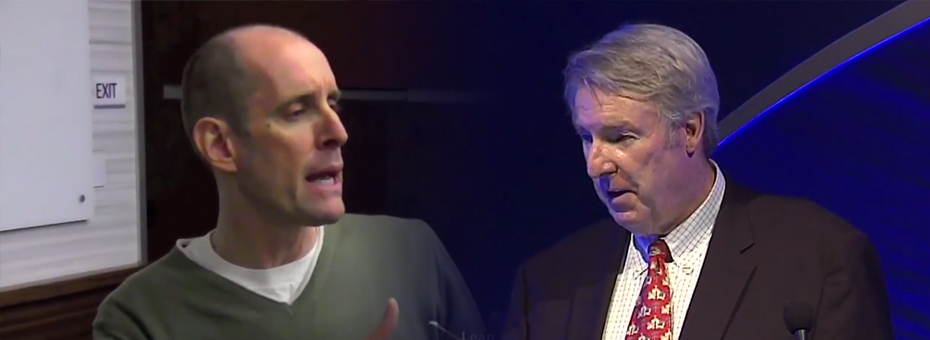Dan Markovitz: Dramatic change works for you – yet it seems so counterintuitive…
 Art, you’ve had enormous success with a “shock and awe” approach to introducing lean in a company. You buy a company, and seemingly on Day 1, you ride in and start swinging sledgehammers, moving machines, rearranging customer service departments, etc. No incrementalism for you. And the companies you’ve been involved with, from Wiremold to UGH (the fictional company in the Lean Turnaround Action Guide) have reaped enormous benefits.
Art, you’ve had enormous success with a “shock and awe” approach to introducing lean in a company. You buy a company, and seemingly on Day 1, you ride in and start swinging sledgehammers, moving machines, rearranging customer service departments, etc. No incrementalism for you. And the companies you’ve been involved with, from Wiremold to UGH (the fictional company in the Lean Turnaround Action Guide) have reaped enormous benefits.
And yet, something feels wrong about this to me. Notwithstanding your track record, everything I’ve read and experienced first-hand as a lean consultant has taught me that dramatic change seldom works. Dr. Robert Mauer, professor of behavioral science at UCLA, shows that large-scale change activates the fight or flight response — so we’re better to make incremental change. And common sense dictates that people in an organization need to build up their improvement “muscles” — you don’t train for a marathon by running 20 miles on the first day if you’ve never run before. Your approach seems to work, but I just don’t get it.
Art Byrne: It’s the only approach that’s worked for me
 I don’t know what to tell you. You either want to get better or you don’t; and a tippy-toe approach just doesn’t work very well. Almost every company that I have seen that tried the slow and gentle approach failed at converting to lean. The nay-sayers always won out, little was accomplished, and they were able to return to their happy place in the status quo. That said, no matter how you go about it, about 95 percent of all lean conversions fail anyway, so I guess you could argue that we both are right. Whether fast or slow, those that succeed at lean do so due to leadership no matter the pace.
I don’t know what to tell you. You either want to get better or you don’t; and a tippy-toe approach just doesn’t work very well. Almost every company that I have seen that tried the slow and gentle approach failed at converting to lean. The nay-sayers always won out, little was accomplished, and they were able to return to their happy place in the status quo. That said, no matter how you go about it, about 95 percent of all lean conversions fail anyway, so I guess you could argue that we both are right. Whether fast or slow, those that succeed at lean do so due to leadership no matter the pace.
Dan: What’s the real root cause though?

Your response is brief and direct — just like your lean initiatives, I suspect!
It sounds like you’re saying a tippy-toe approach means that you don’t really want to get better. I don’t think that’s fair. There are legions of workers who have been scarred by stupid leadership decisions that have caused pain, embarrassment, or frustration. And: how do you know that the slow and gentle approach is the root cause for the failure to convert to lean? Isn’t it possible that there are other factors causing people to return to their happy place? Correlation is not causation, after all.
I believe that you can have an unshakeable, unwavering, resolute commitment to lean without busting out the sledgehammers on Day 1 and turning everyone’s (work) world upside-down. I’d also argue that we might be able to win hearts and minds if we start by — in the words of Paul Akers — fixing what bugs you. After all, as Shigeo Shingo said: “There are four purposes of improvement: easier, better, faster and cheaper. These four goals appear in the order of priority.” Wouldn’t we be better off if we start by helping people see that lean means making their lives easier — even if we’re starting someplace really small, like raising their computer monitors, or putting wheels on the garbage cans? Those improvements won’t move the needle on corporate performance, but they might get people to buy into lean — rather than just thinking, “The boss is nuts, but he’s the boss, so I guess I’ll go along.”
Art: Even if the approach is fast, the transformation is still slow
 You can approach this any way you want and still be successful, I suppose. But keep in mind that however you go about it, converting to lean is a slow, step-by-step process. Whether you go slow or fast, you are still trying to remove waste everywhere: that in turn will make people’s jobs easier and safer while at the same time delivering more value to the customers. My experience is that jumping in and going fast is the best method, as it gets people on board quicker, makes it more difficult to backslide, protects everyone’s jobs and delivers the most value to the customer.
You can approach this any way you want and still be successful, I suppose. But keep in mind that however you go about it, converting to lean is a slow, step-by-step process. Whether you go slow or fast, you are still trying to remove waste everywhere: that in turn will make people’s jobs easier and safer while at the same time delivering more value to the customers. My experience is that jumping in and going fast is the best method, as it gets people on board quicker, makes it more difficult to backslide, protects everyone’s jobs and delivers the most value to the customer.
It sounds to me like you would have a hard time with the idea that setting stretch goals is important to the lean conversion. To me, asking for anything less in fact shows tremendous disrespect for your people: saying “let’s go slowly and only reach for goals we know we can achieve so that no one will get discouraged.” I look at it the exact opposite way. I have tremendous faith in the abilities of all my people and what they can achieve when challenged. You may have to help them along the way and keep pushing, but there is no better feeling than watching a team reach or exceed a goal that they all believed was impossible when it was first mentioned. This to me is what showing respect for people is all about.
For example, at Wiremold we were normally able to achieve a 90 percent reduction in setup time after a one-week kaizen. So, if we know this is possible, should we therefore establish a setup reduction target of, say, 10 percent for the first kaizen because some philosophy professor doesn’t want anyone to get upset? What do you think will make people feel better at the end of the week, achieving a 15 percent reduction when the goal was 10 percent or achieving 85 percent when the goal was 90? Does the guy who got 85 percentl work more, or less, on each setup than the guy who got 15 percent? Look, I know I’ll never convince you but that is fine. Your approach can still result in a very good lean conversion provided you have the leadership in place to keep everyone on track over a long period of time. I’ve found, however that the company taking the more aggressive approach will be far ahead of the company taking the more gradual approach in terms of results and employee satisfaction, let alone the value given to the customer. I’ll stay with the faster more aggressive approach. It always seems to work.
Dan: A case of “The Tortoise and the Hare?”
 You’ve made some pretty compelling arguments here. One comment in particular makes me think that there’s a fair bit of common ground between us. You write, “Converting to lean is a slow step-by-step process however you do it.” I interpret this to mean that even if you rip apart the production area in the first week, you see this as nothing more than the first step in a long, long journey. On this, I wholeheartedly agree.
You’ve made some pretty compelling arguments here. One comment in particular makes me think that there’s a fair bit of common ground between us. You write, “Converting to lean is a slow step-by-step process however you do it.” I interpret this to mean that even if you rip apart the production area in the first week, you see this as nothing more than the first step in a long, long journey. On this, I wholeheartedly agree.
Nevertheless, is it possible that you and I represent the classic tortoise-and-hare contrast? I’m certainly not accusing *you* of being exactly like Aesop’s hare and slacking off after the early lead — your success at Wiremold and other firms clearly shows that you’re no slacker — but what about other companies that don’t have the benefit of your leadership? The corporate landscape is littered with the carcasses of abandoned lean initiatives, and I suspect that there are a fair number of cases where the leadership started lean with a bang and ended with a whimper.
Bringing people along slowly might actually help them to better internalize and understand what they’re doing. For example, I could have a math teacher help me solve a problem in calculus, but it’s better (if slower) if I first get a solid foundation in algebra. Similarly, I could have a sensei set up a work cell or a kanban for me, but I wouldn’t understand it with any depth.
So, if we are dealing with a tortoise and hare situation, does this mean that how lean is introduced matters far less than simply having relentless commitment from leadership?
Art: It’s all about the leadership
 Relentless commitment from the leader or leadership is the basic requirement if you are going to have a successful lean conversion, regardless of whether you choose the fast approach or a slow one. The main issue with getting more companies to move to lean is and always has been “how do you get the CEO interested in the first place?” If the CEO won’t lead the charge, your chances of success are very low.
Relentless commitment from the leader or leadership is the basic requirement if you are going to have a successful lean conversion, regardless of whether you choose the fast approach or a slow one. The main issue with getting more companies to move to lean is and always has been “how do you get the CEO interested in the first place?” If the CEO won’t lead the charge, your chances of success are very low.
Back when I was a Group Executive at Danaher Corporation we took all 13 of Danaher’s Division Presidents to Japan for a week to see lean in action at various Japanese companies. When we returned, each of these presidents attended a three-day kaizen at one of our plants every six weeks, so that they could participate in and start to understand just how much gain you could get from a kaizen in just a few days. At first they bitched and complained. But after about three kaizens they tried to make sure they never missed one because they were learning so much.
So part of jumping in and as you say, “ripping apart the production area in the first week” is simply to show the CEO and the rest of his team how much gain you can get in a short period of time. The gains are always very big and we don’t “rip apart” anything: we make improvements. Even with this it is often hard to get the CEO’s attention. As a result, your go-slow approach is even less likely to get the CEO’s attention. It will have little impact on the company and as a result things will just drift back to the way they were. Even with what you call the “rip things apart” approach change occurs very slowly. Every kaizen will have exceptional results but you are only working on one area or machine at a time. We got an average of 90 percent reduction in setup time during a one week kaizen but that was on one machine. Let’s say there are 200+ machines. Even with dramatic results, most CEOs will only try to run one kaizen every six weeks or so. You won’t get very far doing that. You need to be running two kaizen per week per facility to be successful and very few people are willing to go at that pace. And even then, my experience is that it takes even a committed management team who is achieving great things about four years before they wake up and can start to see all the opportunity that still exists.
I think the only way your go-slow approach can work is if you already have a lean zealot as CEO who will never waver from the path and is willing to take baby steps over a very long period of time. In fact, the way you seem to describe it, you seem to think in traditional terms about improvement. By this I mean a group of salaried people coming up with ideas on how to improve and then implementing them on the hourly people. First we’ll do some training etc. and take it slow so people will understand it and buy in. Our kaizen approach uses teams that are divided evenly between salaried and hourly employees, and always includes the people doing the work we are trying to improve. The best ideas for improvement always come from the people who are doing the work. So we are getting buy in and lots of learning by a broad spectrum of people every time we run a kaizen. If we “rip apart” your work area and make your job way easier and safer are you going to be mad at me? Do you think you would have preferred that I take 6 months of small steps to make your work easier instead of having it be way easier and safer by the end of this week? I think you get the point. I certainly won’t think any less of you if you want to go slowly and make converting to lean some sort of academic or training exercise. Be my guest and good luck with that. As for me, going as fast as I can still takes a long time and is very difficult but I don’t know a better way so I’ll stick with what I know works.
Dan: It’s apples to oranges
 You’ve made a powerful argument for your approach — enough so that I’m wavering in my commitment to the “go slow” approach.
You’ve made a powerful argument for your approach — enough so that I’m wavering in my commitment to the “go slow” approach.
Your last comments make me think that our different perspectives might be due to our respective positions. You’ve been the CEO, and — even if you’re not a command and control kind of leader — you have the ability to drive lean at the speed you want. Coming in from the outside as a consultant (and not a Japanese one), I don’t have the same kind of power and authority, and my ability to engage the CEO and the rest of the leadership team is constrained. For that reason among others, I think, I’ve defaulted to the slow and steady approach.
But you’ve got me reconsidering my thinking and my preconceptions. So thank you for engaging in this dialog.
Now that you’ve heard both sides of the discussion, where do you stand? Are you Team Art or Team Dan? Leave a comment and let us know your thoughts.





